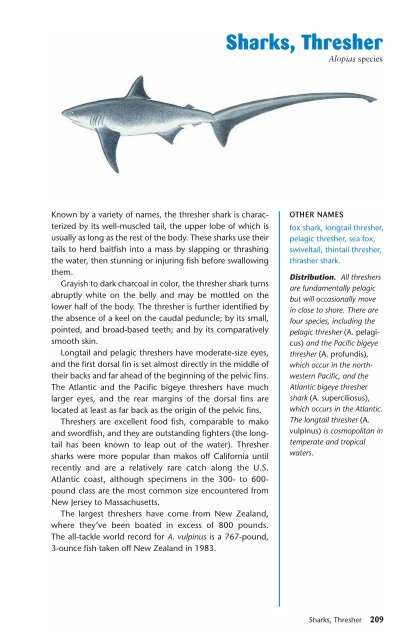Ken Schultz's Field Guide to Saltwater Fish - Macaw Pets store
Ken Schultz's Field Guide to Saltwater Fish - Macaw Pets store
Ken Schultz's Field Guide to Saltwater Fish - Macaw Pets store
You also want an ePaper? Increase the reach of your titles
YUMPU automatically turns print PDFs into web optimized ePapers that Google loves.
Known by a variety of names, the thresher shark is characterized<br />
by its well-muscled tail, the upper lobe of which is<br />
usually as long as the rest of the body. These sharks use their<br />
tails <strong>to</strong> herd baitfish in<strong>to</strong> a mass by slapping or thrashing<br />
the water, then stunning or injuring fish before swallowing<br />
them.<br />
Grayish <strong>to</strong> dark charcoal in color, the thresher shark turns<br />
abruptly white on the belly and may be mottled on the<br />
lower half of the body. The thresher is further identified by<br />
the absence of a keel on the caudal peduncle; by its small,<br />
pointed, and broad-based teeth; and by its comparatively<br />
smooth skin.<br />
Longtail and pelagic threshers have moderate-size eyes,<br />
and the first dorsal fin is set almost directly in the middle of<br />
their backs and far ahead of the beginning of the pelvic fins.<br />
The Atlantic and the Pacific bigeye threshers have much<br />
larger eyes, and the rear margins of the dorsal fins are<br />
located at least as far back as the origin of the pelvic fins.<br />
Threshers are excellent food fish, comparable <strong>to</strong> mako<br />
and swordfish, and they are outstanding fighters (the longtail<br />
has been known <strong>to</strong> leap out of the water). Thresher<br />
sharks were more popular than makos off California until<br />
recently and are a relatively rare catch along the U.S.<br />
Atlantic coast, although specimens in the 300- <strong>to</strong> 600pound<br />
class are the most common size encountered from<br />
New Jersey <strong>to</strong> Massachusetts.<br />
The largest threshers have come from New Zealand,<br />
where they’ve been boated in excess of 800 pounds.<br />
The all-tackle world record for A. vulpinus is a 767-pound,<br />
3-ounce fish taken off New Zealand in 1983.<br />
Sharks, Thresher<br />
Alopias species<br />
OTHER NAMES<br />
fox shark, longtail thresher,<br />
pelagic thresher, sea fox,<br />
swiveltail, thintail thresher,<br />
thrasher shark.<br />
Distribution. All threshers<br />
are fundamentally pelagic<br />
but will occasionally move<br />
in close <strong>to</strong> shore. There are<br />
four species, including the<br />
pelagic thresher (A. pelagicus)<br />
and the Pacific bigeye<br />
thresher (A. profundis),<br />
which occur in the northwestern<br />
Pacific, and the<br />
Atlantic bigeye thresher<br />
shark (A. superciliosus),<br />
which occurs in the Atlantic.<br />
The longtail thresher (A.<br />
vulpinus) is cosmopolitan in<br />
temperate and tropical<br />
waters.<br />
Sharks, Thresher 209


